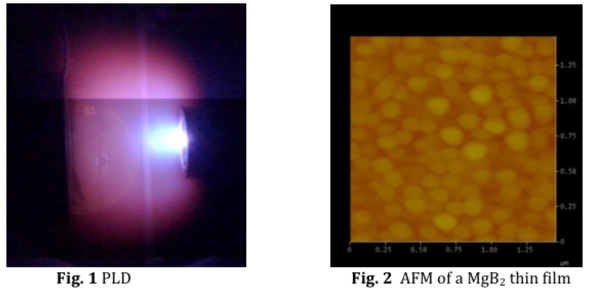| Home | Research | Members | Alumni | Publications | Album | Links | Old Site | Internal |
Research
Low Spin-Orbit Interacting Superconductor Thin Films and Some Related Topics
Li Zhang
Aharon Kapitulnik
Malcolm Beasley
1. Fabrication and characterization of thin film (on-going)
Thin films of superconductor materials (magnesium diboride, MgB2, titanium nitride, TiN) and topological insulator (bismuth telluride, Bi2Te3) have been fabricated using the pulsed laser deposition method. Laser frequency, laser intensity, deposition temperature, in situ annealing temperature and some other parameters are adjusted to optimize film growth. X-ray photoemission spectroscopy (XPS), atomic force microscopy (AFM), and X-ray reflection and diffraction are commonly used to characterize the films, providing information about chemical composition, surface topology, crystal structure and thickness of the films. Electronic and magnetic properties of the films are usually measured in PPMS and MPMS, respectively.

Ref. W. Siemons, M.A. Steiner, G. Koster, D. H. A. Blank, M. R. Beasley and A. Kapitulnik. Phys. Rev.B 77, 174506 (2008)
2. Low temperature transport measurement for superconductor-insulator transition study (on-going)
Superconductor-insulator transition in quasi 2-dimensional systems has been studied in thin films of MgB2 and TiN, mainly by doing low temperature transport measurements in either a commercial physical property measurement system (PPMS), in which the temperature can go down to 2 Kelvin, or a helium-3 system, in which the temperature can go all the way down to 0.3 Kelvin. Van der Pauw configuration is normally adapted for the 4-point transport measurement.

3. Tunneling measurement for the proximity effect study (future plan)
In conventional BCS superconductors, electrons with opposite spins form Cooper pairs, while in ferromagnets, spin of electrons aligns in the same direction. If a BCS superconductor is put in proximity of a ferromagnet, interesting phenomenon, such as the oscillation of the transition temperature with the thickness of the ferromagnet layer, the inversion of the density of superconducting states, can arise from the competition of those two different orders. To study the proximity effect in superconductor-ferromagnet hetero-structure systems, planar tunneling experiment is a powerful tool since it measures directly the density of states in the systems. In some studies that have been done in this group, the inversion of the density of superconducting states was observed, and some intriguing phenomena such as a robust subgap was also observed and a quantitative explanation for this is still lack. Further studies in similar systems are needed to establish a complete picture for understanding this kind of systems.
Another similar system, superconductor-topological insulator heterostructures have been attracting more and more attention now, because of the specific band structure and properties of topological insulators. The theoretical prediction of Majorana excitation in the interface has not been detected in experiments yet. After we can make thin bismuth telluride films of good quality, we will move on to deposit thin films of superconductor on top/bottom of the topological insulator, and then probably use planar tunneling and some other technique to study this kind of system. It will be exciting!
Ref. P. SanGiorgio, S. Reymond, M. R. Beasley, J. H. Kwon, and K. Char. Phys. Rev. Lett. 100, 237002 (2008)

| Home | Research | Members | Alumni | Publications | Album | Links | Old Site | Internal |
© KGB group, all rights researved.